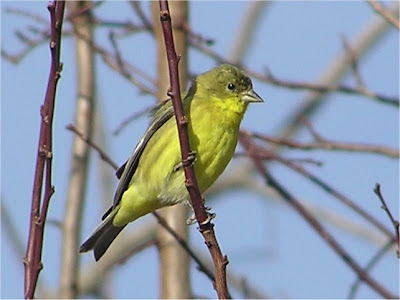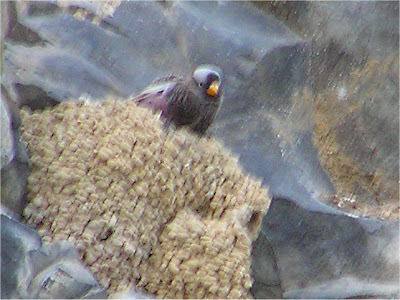Cyndi and I shared great outdoor adventures, wonderful meals, and quiet companionship.
I visited the Florida Everglades in winter (when it is 70 degrees there), the California Redwoods in spring (with the Rhododendron in bloom), and Maine's Acadia National Park in the late summer (after the flies have gone).
And I saw last year's huge losses from my modest retirement accounts recover amazingly well. Though I don't covet a lot of money, I do dream of a retirement. I can see it out there on the horizon, and suspect it will arrive one day.
Though those top 10 lists can be tedious, I'd like to celebrate with a Top 10 Birds of 2009! Sometimes I was excited to be seeing new birds for the first time, other times I was pleased to create a nice photo of a bird I knew before. So, here are my Top 10, and yes, of course, I took the photos myself with my inexpensive little Olympus C-750. Click on the photos to see them larger and in more detail ... use your browser's "back" button to return to this page.
10. Northern Saw-whet Owl. Everybody loves owls and hummingbirds, right? I have a tough time finding owls, so when I do see one it is a treat. Usually they're out at night. This year I've twice felt the rush of air as owls brushed by me at night ... once as it powered to a stop mere feet from my face, then slowly rose away from me ... both of us no doubt somewhat shaken by the near collision. (Yes, they have good night vision but when automobile headlights momentarily blind them, then they can come amazingly close to hitting someone in the face!)

9. White-eyed Vireo. It's no secret that I like a bird that has a name and feature that make it hard to get the identification wrong. I got quite a few wrong this year, which means I learned a lot. I'm really very, very confident I've identified this one accurately ... but am always ready to be corrected by those who know. This one has a lot of detail if you click on it to see the larger image.

8. Yellow-throated Warbler. There are many warblers, and lots of birds with yellow throats, but I'm certain the naturalist at Everglades National Park knows her birds well. Her enthusiasm for birding was evident as a Peregrine Falcon flew low over a pond and just for a moment began, then terminated, its stoop (a dive intended to kill prey). She proclaimed, "I love my job!" Those of us who enjoy birding merely as a hobby can only imagine what it might be like to be paid to go birding.

7. The Green Heron has a number of subtle shades of green in its plumage. This one is best viewed large, by clicking on the photo. You ought to see the length they grow to as they stretch out to snatch a fish from the water, all the while gripping their perch with those powerful feet.

6. Though I've seen the Black Tern before, it has always been from a great distance. By taking a canoe trip with my sister, into the Upper Klamath National Wildlife Refuge in Oregon I was able to approach very close for this photo.

5. I think of 2009 as the "Year of the Grouse" because I found and photographed so many species of Grouse new to me. One has to get up pretty early in the morning to see them strut on their lek (a dancing-ground where males gather to vie for the attention of the females who watch from the edges). This one is the Greater Sage-Grouse. These birds are declining in numbers due to loss of their habitat.

4. For sheer color and quirkiness, the Purple Gallinule is one of my favorites. I had gone to the north side of Everglades National Park and was told this bird might be found there. I was on my way back to the car, walking along a slough and stopped to photograph a blackbird. I sat down by the edge of the water, just enjoying the moment, when this bird came out of the thick growth on the far side. To my surprise it began to flap its wings and run with those big yellow feet across the lily pads, skipping and ziz-zagging until it came to rest at my feet, nearly too close to focus. I zoomed out and in the perfect, soft light captured detail in the dark of the eye and the bright shield on its forehead. Click on the image to see what I mean.

3. Most of the time I enjoy a photo that shows a single bird with all the field marks that make it unique easily seen in the photo. But this picture's early dawn light and sense of activity and movement nicely capture a unique moment. I've made this one my computer wallpaper and never tire of looking at it. Be sure to click on this one, to make it larger and find more birds that appear in the background!

2. After seeking without success for some time, I received good directions from my friend Rich and excellent navigation assistance from Cyndi, and was blessed with nice light and a carefree disposition that caused these Black-throated Sparrows (a pair raising young nearby) to fly to the perfect spot for a photo of them in their habitat -- rocky slopes with thorny vegetation.

1. And, the top bird picture for 2009 has to be this photo which I probably won't be able to recreate if I try for the rest of my life. A Red-winged Blackbird sending a Great Egret out of its territory with a peck to the butt, taken at the Lower Klamath National Wildlife Refuge in California.
 May your 2010 be filled with adventure and discovery, peace and joy. Happy New Year.
May your 2010 be filled with adventure and discovery, peace and joy. Happy New Year.












































